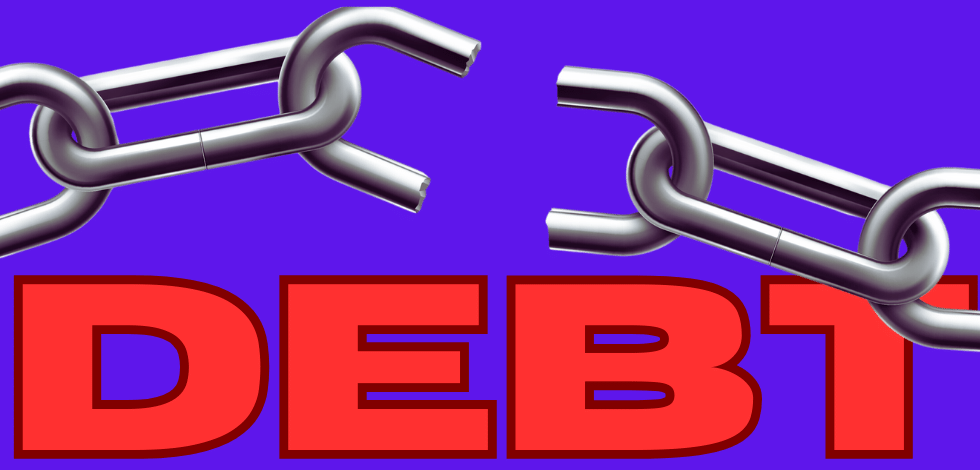Break Up with Debt: How to Get Out of Debt (and Stay Out!)
January 29, 2024

Many Americans find themselves a slave to the rinse-and-repeat pattern of paying off debt only to run balances back up. If you want to be debt-free for good, follow these six steps.
Assess Your Financial Landscape
Becoming debt-free doesn't just happen overnight. A debt-free life requires you to look at your financial picture holistically and honestly. You need to assess expenses and spending habits and be willing to make changes that may not always be easy or fun.
A crucial step is to assess your income and understand its sources and stability. Take note of your income, whether it be a salaried job or freelance work. Consider any potential fluctuations or irregular income streams that may affect your overall financial picture. By having a clear understanding of your income, you'll be better equipped to plan your debt-busting strategy.
Next, you'll need to delve into your expenses. It's important to review your expenses every six to twelve months, or anytime you experience a change, like increased medical expenses or income tax withholdings. Once you have reviewed them and know exactly what your expenses are each month, you'll need to categorize them into essential and non-essential categories, ensuring that you have a comprehensive overview of where your money is going each month. This process may reveal areas where you can cut back or make adjustments to free up more funds for your debt repayment journey.
Now, it's time to confront your debt head-on. List out each of your debts, including credit cards, loans, and any other outstanding balances. Take note of each debt's interest rates, minimum payments, and due dates. This information will serve as your compass, guiding you toward the most effective debt repayment strategy.
With your financial landscape fully mapped out, it's time to set your sights on your financial goals. Envision the life you want, whether buying a house, starting a business, or saving for retirement. Your financial goals will act as your North Star, guiding your decisions and motivating you to stay on track throughout your debt-busting expedition.
Remember, this journey toward financial independence is not about deprivation or sacrifice; it's about gaining control and freedom. By thoroughly assessing your financial landscape and identifying your goals, you are laying the foundation for a debt-free future.
Create a Budget That Doesn't Suck
Budgets – they're like kale salads for your finances. You might not love them at first, but trust us, they're good for you. It's important that your budget fits your lifestyle. This means it allows the occasional guilt-free indulgence while still prioritizing debt repayment. Remember, a budget is not a punishment; it's your financial GPS guiding you toward a debt-free destination.
It's the 21st century, which means you don't have to sit down with a fresh notebook and pen and try to figure out budgeting on your own. There are many budgeting resources available to you, most of which are free. One of these resources is iThrive, an online budgeting platform that is free to Education First members through our online banking platform. Take advantage of this service or one like it to help set you up for success.
Tame the Credit Card Monster
Credit cards can be incredibly tempting, luring you into a false sense of financial security that, if left unchecked, can quickly become mischievous gremlins wreaking havoc on your finances. A recent survey concluded that the average interest rate on credit card debt is a whopping 28.07%. To tame the credit card monster, you need a multi-faceted approach.
Firstly, consider consolidating your high-interest debts. By transferring balances to a single credit card or taking out a debt consolidation loan, you can simplify your payments and potentially lower your interest rates. This can make it easier to manage your debt and save money in the long run.
In addition, try to minimize your reliance on credit cards for everyday purchases. Instead, opt to use cash or debit cards whenever possible. This will help you break the habit of relying on credit and ensure that you only spend what you have.
To further rein in destructive spending habits, consider closing unnecessary credit card accounts. Big box stores and department stores often offer credit cards with significantly higher interest rates. By closing these accounts and sticking to just one credit card with a low interest rate for emergencies, you can reduce the temptation to overspend.
Remember, taming the credit card monster is not a one-time task. It requires ongoing diligence and discipline. Regularly review your credit card statements to track your spending and identify any areas where you can cut back. Stay committed to your budget and financial goals, and with time, you'll regain control over your finances and conquer the credit card monster once and for all.
End the Endless Impulse Shopping Cycle
Consider if your own spending habits may be your downfall to managing your debt. Making a budget is one thing, but ensuring that you're breaking bad financial habits is crucial to paying off your debt and avoiding new debt. One way to ensure that you won't fall back into your old habits is to remove all credit cards from your digital wallet and any saved information at checkout on websites where you are prone to impulse shopping. This means taking the extra step of deleting your credit card information from online platforms and apps that store your payment details for convenience. By doing this, you eliminate the temptation to make impulsive purchases with just a click of a button.
Instead, consider using alternative payment methods that require a more deliberate decision-making process. For example, you can opt to use a prepaid debit card for online purchases. This way, you'll need to physically load money onto the card before making a purchase, which gives you time to evaluate whether the item is a true necessity or simply an impulse buy.
Additionally, it can be helpful to implement a waiting period before making any non-essential purchases. When you find something you want to buy, give yourself at least 24 hours to think it over. This allows you to consider whether the purchase aligns with your financial goals and whether it's truly worth the expense. Often, you'll find that the initial desire to buy something diminishes after giving yourself some time to reflect.
Another effective strategy is to create a list of your financial goals and keep it easily accessible. Whenever you feel the urge to make an impulse purchase, refer to your list and remind yourself of what you're working towards. This can help you stay focused on your long-term objectives and resist the temptation of instant gratification.
Build an Emergency Fund Fortress
Life has a funny way of throwing curveballs when you least expect them. That's where your emergency fund comes into play. Aim for at least three to six months' worth of living expenses in an easily accessible account. A money market checking account is a good choice because it earns a higher interest rate than a regular savings account, and that rate typically increases the more you save. Having an emergency fund not only provides financial reassurance but also helps prevent you from going back into debt when the unexpected comes your way.
Snowball or Avalanche? Pick Your Debt-Busting Weapon
The debt snowball and debt avalanche methods are like Batman and Superman – both superheroes but with different strategies. The snowball method involves paying off the smallest debts first, gaining momentum as you roll along. The avalanche method, on the other hand, targets high-interest debts first, aiming to minimize overall interest paid. Use these free online debt payoff calculators to determine which is right for you.
Invest in Financial Literacy
Knowledge is power, especially when it comes to your finances. Invest time in expanding your financial literacy – read books, attend workshops, and follow reputable financial blogs. The more you understand the world of money, the better equipped you'll be to make informed decisions and secure your financial future.
Education First offers a variety of tools to help members increase their financial know-how. Our blog, the Vault, covers a variety of topics focused on helping you reach your financial goals - just hit subscribe below to get notifications in your inbox anytime we publish new content. We also partner with Zogo, a gamified app that allows users to earn real rewards (think gift cards) for completing bite-sized financial literacy courses via the app. You literally get paid to earn - it just doesn't get any simpler.
Patience is a Virtue
Remember, Rome wasn't built in a day, and your debt-free empire won't be either. Stay committed, stay positive, and keep moving forward. At Education First Federal Credit Union, we're here to support you every step of the way. Questions about debt consolidation options? Give us a call or drop us a line - our friendly and experienced team members are here to help you achieve your financial goals, today and every day.


.png?width=352&name=Debt%20Consolidation%20(1).png)

